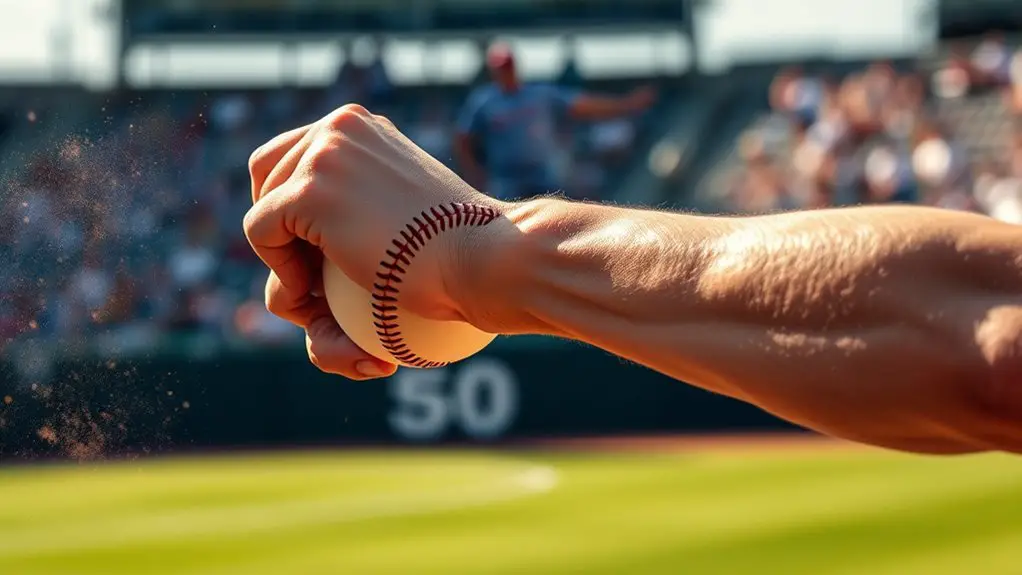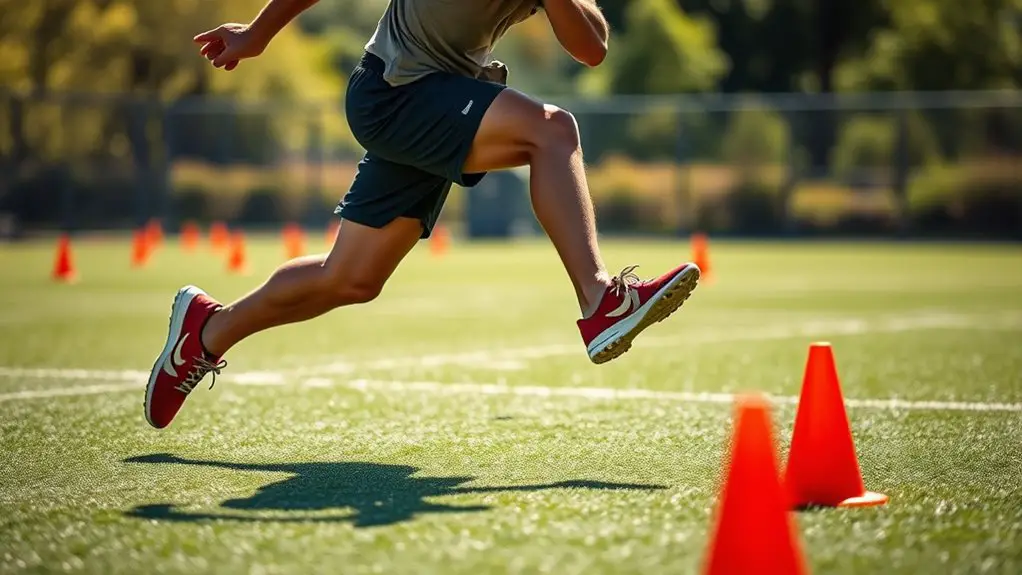Wrist strength is key for pitchers because it directly influences pitch accuracy, velocity, and control. A flexible and strong wrist helps enhance your grip and spin on the ball, allowing for better hand positioning and more effective pitches. Additionally, conditioning your wrists can prevent injuries and support smooth throwing mechanics, letting you pitch longer without fatigue. If you're interested in enhancing your training routine, there are proven exercises and insights that can take your performance to the next level.
The Anatomy of the Pitcher's Wrist
The wrist is an essential component in a pitcher's mechanics, acting as a dynamic link between the arm and the hand. Understanding wrist anatomy is vital for any aspiring pitcher. The intricate structure includes bones, ligaments, and tendons that all work together to provide the flexibility needed for effective pitching. A flexible wrist allows you to whip through your pitches with speed and precision, enabling you to maintain control while exploring various throwing styles.
Having good wrist flexibility not only enhances your ability to snap the ball but also reduces the risk of injury. When your wrist can move freely, it helps in achieving that perfect release point, significant for accuracy. Grip strength plays a crucial role in stabilizing the wrist during pitches, ensuring consistent performance. So, pay attention to your wrist's health and flexibility; it's not just about strength. Embrace exercises that promote mobility, and you'll see how they can elevate your game, giving you the freedom to express your unique pitching style.
The Role of Wrist Strength in Pitching Mechanics
Wrist strength plays an essential role in your pitching mechanics, affecting both your grip and control. A strong wrist contributes to a powerful wrist snap, which can greatly enhance your pitch velocity and accuracy. By focusing on wrist strength, you can improve your overall performance on the mound.
Wrist Snap Importance
When it comes to pitching, having a strong wrist can make all the difference in your performance. A powerful wrist snap is essential for generating speed and movement on the ball. It's not just about arm strength; it's about finesse. By mastering wrist snap techniques, you can enhance your pitching mechanics, allowing for better velocity and accuracy. Incorporating wrist snap drills into your training routine can strengthen those muscles, improving your overall effectiveness on the mound. Think of each pitch as an opportunity to release that snap, adding an extra edge to your game. Embrace the freedom of motion, and remember that a well-executed wrist snap can elevate your pitching to new heights. Your potential is waiting!
Grip and Control
While many pitchers focus on arm strength, grip and control are heavily influenced by wrist strength. A strong wrist provides the necessary wrist flexibility to maintain control over your pitches, allowing you to place the ball precisely where you want it. When your wrist is strong and flexible, you can generate the grip endurance needed to hold onto the ball firmly during your delivery. This guarantees you can execute various pitches, from fastballs to curveballs, with confidence and finesse. Without adequate wrist strength, you might struggle with consistency, leading to wild pitches and lost opportunities. So, prioritize wrist workouts in your training routine, and watch your grip and control improve dramatically on the mound.
Enhancing Grip and Spin With Strong Wrists
To achieve ideal performance on the mound, it's essential that you develop strong wrists, as they play a significant role in enhancing grip and spin on the ball. By focusing on wrist flexibility and rotational strength, you can release your full potential as a pitcher. Strong wrists allow you to maintain a firm grip on the ball, ensuring control over your pitches. When you improve your wrist flexibility, you can easily adjust your hand position, which is imperative for executing various pitches.
Additionally, incorporating rotational strength exercises will help you generate more spin, giving your fastballs and breaking balls that extra edge. Think about it: when your wrists are strong and flexible, you'll feel freer and more confident in your throws. So, take the time to work on your wrist strength and flexibility—your performance will thank you, and you'll see the results translate right back to the mound. Furthermore, developing core strength can enhance your overall stability, allowing for a more powerful and controlled pitching motion.
Injury Prevention Through Wrist Conditioning
Conditioning your wrists is essential for enhancing your throwing mechanics and reducing the risk of injuries. Strengthening your grip also plays a vital role in maintaining control and precision during pitches. By focusing on wrist health, you'll not only protect yourself but also improve your overall performance on the mound. Additionally, incorporating flexibility and mobility work into your training routine can further enhance joint function and decrease injury risk.
Enhanced Throwing Mechanics
Enhanced throwing mechanics are essential for preventing injuries in baseball pitchers, especially since the wrist plays a pivotal role in generating speed and accuracy. By focusing on wrist flexibility and endurance, you're not just enhancing your performance; you're also protecting yourself from potential injuries. A flexible wrist allows for a smoother throwing motion, helping you achieve better control and precision. Meanwhile, building wrist endurance guarantees that your muscles can withstand the demands of repeated pitches without fatigue. As you strengthen these areas, you'll notice an improvement in your overall mechanics, giving you the confidence to release your full potential on the mound. So embrace wrist conditioning; it's your key to better throwing mechanics and a more liberated pitching experience.
Reduced Injury Risk
Wrist conditioning plays a significant role in reducing injury risk for baseball pitchers. When you focus on strengthening your wrists, you're not just building power; you're also enhancing stability and flexibility. This conditioning helps prevent strains and sprains during intense pitching sessions. By incorporating wrist exercises into your routine, you're promoting better joint health, which is essential for injury prevention. Strong wrists allow for more control over your pitches, reducing the likelihood of overexerting yourself and leading to injuries. Plus, when your wrists are conditioned, you can throw with more confidence, knowing you're less prone to setbacks. Ultimately, investing time in wrist conditioning is key to keeping you on the mound and enjoying the game without the nagging worry of injuries.
Improved Grip Strength
A strong grip is essential for any baseball pitcher, as it directly impacts your ability to control the ball. Improved grip strength not only enhances your performance but also contributes to injury prevention. By focusing on grip dynamics and wrist flexibility, you can guarantee your wrists are conditioned for the demands of pitching.
- Better ball control during pitches
- Reduced risk of wrist and forearm injuries
- Enhanced overall pitching mechanics
- Increased ability to throw various pitches
- Greater endurance throughout the game
Investing time in wrist conditioning exercises can lead to freedom on the mound. Embrace the power of a strong grip, and you'll find yourself throwing with confidence, knowing your wrists can handle the pressure of the game.
Exercises to Build Wrist Strength for Pitchers
To guarantee you have the strength needed for effective pitching, incorporating specific exercises for your wrists is essential. Start with wrist curls; they're simple yet powerful. Grab a light dumbbell, rest your forearm on a bench, and curl your wrist upwards. Aim for three sets of 10-15 reps to build endurance and strength.
Next, use grip trainers to enhance your grip strength. These devices help you develop the muscles needed for a firm hold on the baseball, which is vital for control and accuracy. Squeeze and hold the grip trainer for 5-10 seconds, then relax. Repeat this for about 15-20 reps.
Finally, don't forget about wrist rotations. Hold a weight in your hand and rotate your wrist in circles to work those stabilizing muscles. Consistency with these exercises will give you the wrist strength you need to pitch effectively and confidently. Additionally, focusing on overall strength through compound movements like deadlifts can further enhance your performance on the mound.
The Connection Between Wrist Strength and Velocity
While many factors contribute to a pitcher's velocity, the strength of your wrists plays an essential role in maximizing your throwing power. Strong wrists enhance your ability to generate speed and control the ball, impacting both your velocity and throwing accuracy. When you improve wrist flexibility and strength, you reveal a new level of performance.
- Increased snap at release
- Better control over pitch types
- Enhanced whip-like motion in your arm
- Improved energy transfer from your lower body
- Greater overall arm stability
How to Incorporate Wrist Training Into Your Routine
Incorporating wrist training into your routine can considerably enhance your pitching performance. Start by integrating wrist exercises that focus on strength and flexibility. Simple movements like wrist curls, wrist rotations, and grip squeezes can be done almost anywhere, making them easy to fit into your day. Aim for short, effective sessions—10 to 15 minutes—before or after your usual training routines.
You can also add resistance bands for added challenge. Attach a band to a sturdy object and perform various wrist motions. This not only builds strength but improves stability, essential for your pitching mechanics.
Don't forget to mix in mobility work to maintain a full range of motion. Stretching your wrists after workouts can help prevent injuries and keep your joints healthy. By consistently incorporating these wrist exercises, you'll discover just how significant wrist strength is for elevating your game on the mound.
Success Stories: Pitchers Who Prioritize Wrist Strength
Many successful pitchers attribute their achievements to the emphasis they place on wrist strength. By prioritizing wrist training, they enhance their pitching performance and prevent injuries. You can take inspiration from these athletes who've embraced wrist strength as a cornerstone of their success:
- Improved pitch control and accuracy
- Enhanced throwing velocity and power
- Reduced risk of arm injuries
- Greater stamina throughout games
- Increased confidence on the mound
Pitchers like Justin Verlander and Gerrit Cole have openly discussed how wrist exercises transformed their game. They've made a commitment to wrist training, leading to impressive careers and accolades. By incorporating similar techniques into your routine, you'll not only boost your performance but also enjoy the freedom that comes with pitching at your best. Remember, it's not just about throwing hard; it's about throwing smart! Additionally, a strong core stability is essential for overall strength and balance, which further supports effective pitching mechanics.
Frequently Asked Questions
How Does Wrist Strength Affect Overall Pitching Performance?
Imagine you're on the mound, and your wrist isn't as strong as it could be. You struggle with wrist flexibility, making it hard to maintain proper pitching mechanics. This can lead to inconsistent throws and reduced velocity. When your wrist strength improves, you can generate more torque and control, enhancing your overall performance. Strengthening your wrist allows you to release your potential, giving you the freedom to pitch with confidence and precision.
Can Wrist Strength Improve Accuracy in Pitching?
Absolutely, wrist strength can improve your pitching accuracy. When you've got strong wrists, you enhance your grip strength, allowing for better control over the ball's release. Plus, wrist flexibility helps you achieve a smoother motion, leading to more precise throws. By focusing on these aspects, you can liberate your full potential on the mound. So, train those wrists and watch your accuracy soar, giving you the freedom to pitch with confidence!
What Age Is Appropriate to Start Wrist Strength Training?
You can start wrist strength training for kids around age 10, as long as they're ready for youth training. At this age, their bodies are developing, and introducing wrist exercises can promote injury prevention while enhancing overall performance. It is crucial to focus on proper techniques and not overdo it, so they enjoy the freedom of movement without strain. Building strength gradually sets the foundation for a lasting, healthy athletic career.
Are There Specific Wrist Injuries Common Among Pitchers?
Imagine your wrist as a finely tuned instrument, playing an essential role in the symphony of pitching. Yet, like any instrument, it can face wear and tear. Common types of wrist injuries among pitchers include sprains and tendinitis, which can feel like a haunting melody that disrupts your rhythm. To maintain your freedom on the mound, it's vital to recognize these risks and strengthen your wrist, ensuring your performance remains harmonious and injury-free.
How Often Should Pitchers Train Their Wrist Strength?
When it comes to training frequency, you should aim to incorporate wrist exercises into your routine at least two to three times a week. Consistency is key, so finding that balance will help you avoid overtraining while still building strength. You can mix in various exercises to keep things fresh and enjoyable. Remember, your wrists play an essential role in your overall performance, so investing time in them can enhance your game considerably.




